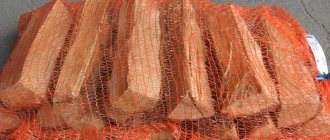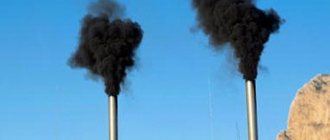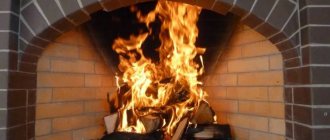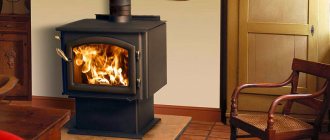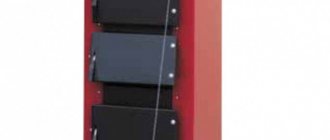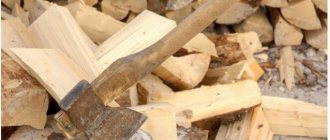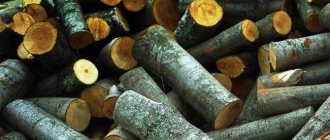If the house uses a wood-burning stove as the main or backup heat source, and in addition to it, the household has a bathhouse, barbecue or smokehouse, the owners have to prepare fuel every year. Moreover, you need to do this wisely, choosing which firewood is best for the stove, and which to stock up on for the fireplace or frying meat on the fire. In this matter, everything is important: the type of wood, humidity, and even the “age” of the firewood. Read the article on how to choose them.
Shooting embers from the open mouth of a fireplace is fraught with fire Source kamin-top.ru
- For a home stove, it burns long and intensely, with minimal ash formation and high heat transfer, allowing you to add fuel and clean the firebox as little as possible.
- It’s also clear what kind of wood is best to heat a sauna - it burns quickly and gives a lot of heat.
The general requirement for all firewood is good combustibility and high heat transfer. These qualities largely depend not only on the type of wood, but also on humidity. Even the most “correct” wood will burn poorly, emitting a lot of smoke and leaving unburnt coals if it is not dried.
Firewood from recently cut trees has the highest humidity, especially if it was harvested during the period of active movement of sap - in spring or summer. The drying speed of different breeds is also different: some require several months, others up to two years, provided they are stored correctly.
It is better to buy firewood cut in winter and store it in a woodpile Source mirlandshaft.ru
Advice! It is easy to determine the degree of moisture in firewood: dry logs make a ringing sound when they hit each other.
Another important selection criterion concerns the ability of firewood to release resinous substances and soot when burning, which clog the chimney. Alder and aspen firewood have the lowest degree of soot formation, while coniferous firewood ranks last in this parameter. For a bathhouse with a straight chimney, this is not very critical - the channel without bends is easy to clean. But for a home brick stove with an elbow chimney, its overgrowing with soot and soot is fraught with loss of draft and related problems.
See also: Catalog of companies that specialize in the design and installation of fireplaces and stoves
The most important characteristics of firewood
Good, high-quality firewood should have the following properties:
- high flammability;
- high heat transfer;
- low ash content;
- low or medium smoke.
All these parameters depend on two factors - the condition of the firewood and the type of wood from which they are prepared. Regardless of what kind of firewood is used in a stove or solid fuel boiler, be it in a house or in a bathhouse, it must be dry.
GarryFORUMHOUSE Member
The stove or fireplace should be heated with air-dried logs with a maximum humidity of 15-25%. Only then will they burn without releasing aggressive substances and effectively provide heat.
The calorific value of firewood varies depending on the type of wood, but even logs of the same type will produce different amounts of heat in dry and wet states. With a humidity of 50%, and for freshly cut wood it can be up to 95%, the specific heat of combustion of a kilogram of firewood is one and a half times lower. Therefore, after harvesting, which necessarily includes chopping logs, the logs are stored in the woodshed for drying. On average, this process takes about two years, but some species dry faster due to the lower moisture content of the wood (birch, ash). If necessary, they can be heated raw, but still not necessary. How much firewood is needed for a season or a year directly depends on the calorific value, and it is still lower for wet ones, therefore, the consumption will be higher. The drying time is also affected by the harvesting season - in any winter firewood the initial humidity is minimal.
Video description
Watch the video to see what improper storage leads to:
For fireplaces and pyrolysis stoves, it is advisable to further dry the fuel by keeping it in a warm and dry place for several days. The “cleaning” firewood – aspen and alder, used for cleaning chimneys – should also be well dried.
It is advisable to harvest oak in advance and put it into use after a year or two - this is the time it takes for the wood to dry. Birch, on the contrary, is used in the year of purchase. Linden is stored for no longer than 2-3 years if you want to enjoy its amazing aroma in the bathhouse.
Wood species for firewood
If you take dry logs of different types, they differ in the intensity of combustion, and in the amount of heat generated, and in the amount of smoke produced and ash remaining after combustion. The calorific value of wood and its flammability are based on density - the denser the structure, the longer it burns and the greater the amount of heat generated. Which firewood will be better in terms of minimal ash content and low smoke production depends on its mineral composition and the presence of resins.
Coniferous species, with the exception of larch, are characterized by low-density wood and strong resinity, which is why they burn very quickly, emit little heat, and produce a lot of soot. Pine wood produces more heat than spruce, but still less than harder types, and when long-burning firewood is needed, they choose anything but coniferous. Plus, pine logs are not suitable for open fireplaces - when burned, due to the bursting resinous pockets, sparks fly in different directions. But coniferous wood also contains essential oils, which is why it is used as fuel for baths or used for kindling. And for the home, if coniferous firewood is the most accessible, it is worth heating with it, especially when the stove is cold or damp. The main species harvested for firewood are deciduous trees – both “wild” and fruit trees. The latter are especially relevant for smokehouses, as they produce aromatic smoke when burned. To prepare the famous Peking duck, the Chinese not only feed the poultry in a special way, but also use exclusively firewood from fruit trees in the process. To understand which kind of firewood is better in all respects, let’s look at deciduous wood.
Primary requirements
The best firewood for heating stoves is dry. Humidity should be within 20%. This is the main requirement. The calorific value of wood depends very much on its moisture content.
Dry wood flares up and burns well, emits more heat, and smokes less. The logs should not be rotten or saturated with water. Water logs are not suitable for heating stoves.
Good firewood leaves little ash. It is advisable to harvest wood in late autumn or winter, when sap flow stops and the wood is denser.
The size of firewood for the stove depends on the size of the firebox, usually 35-40 centimeters long. The thickness is medium, thick logs split. Small logs are easy to light. They also burn quickly, which must be taken into account when preparing them.
Birch firewood
Birch belongs to the category of medium-density wood (550-740 kg/m³), and its ash content varies between 2.43-0.52%. In terms of the amount of heat generated, birch firewood is in the leader group, since the average density is combined with initially lower, and in a dry state, minimal humidity and the presence of tar in the wood composition. However, this carbon compound contributes not only to rapid ignition and intense combustion, but also to increased smoke production with a lack of draft. If you use wet logs and the draft is insufficient, tar will settle on the walls of the chimney. When it is not possible to store and dry a woodpile for a year, but you need to select and heat it in real time, birch will become a real help. The main thing is to ensure good draft so that the wood burns on fire and does not smoke. But for pyrolysis boilers, professionals do not recommend using either wet or dry birch firewood; in this case, other species will be better. Birch bark or splinters are considered the preferred materials for lighting a stove, even if other firewood is of poorer quality.
Calorific value of material
Calorific value is the heat of combustion of raw materials. The heating value of wood depends on this indicator. The index shows which wood is best for the stove. Their choice is also influenced by other factors, each of which may differ significantly from the standards. In field conditions, theoretical calorific value has general indicators. The characteristics are accurately determined in the laboratory, and the results will be correct only for the sample being tested. The experiment consists of burning a prototype and identifying the amount of thermal energy generated.
Calorific value is the amount of heat produced when a certain amount of wood is burned together with accompanying internal substances (esters, oils, etc.). The process releases water vapor, which is generated in two ways:
- due to the hygroscopicity of the material, the pores contain moisture, which turns into steam when heated;
- During the oxidation and decomposition of hydrocarbons, water molecules are synthesized and steam is formed from them.
There are several types of calorific value indicators. Depending on them, the combustion of raw materials used to evaporate water and heat steam is taken into account. These indicators include:
- specific calorific value volumetric;
- specific mass working;
- absolute highest;
- working volumetric lower;
- workers mass lower.
The heat release indicator related to the selected volume of raw materials is called the specific heat of combustion. To determine the amount of energy, standard units of volume (cubic meters, cubic decimeters) are used. The indicator is measured in J/m³ or kcal/dm³. Depends on the density (cellular structure) and concentration of flammable components per unit volume of raw materials. Its characteristics are directly proportional to the name of the wood.
The mass specific calorific value of a sample of a certain quantity is calculated for kilograms or tons of wood. Displayed in J/t or kcal/kg.
The absolute degree (highest) is measured taking into account the heat spent on condensing the steam released during combustion. Condensation energy refers to latent combustion indices. Absolute calorific value is determined by burning a piece of wood of a certain weight or volume in a calorimeter with further cooling of all its components to the initial temperature.
The lower working calorific value in volumetric units does not take into account fuel consumption for condensation of steam released during combustion. Since when the previous indicator is identified, it is practically impossible to cool the components until complete condensation appears, the operating characteristic is widely used in calculations. Determined after combustion of the prototype and cooling of the components without the formation of condensation. A live (undried) sample is used, and its moisture content, measured before use, is recorded in documents.
Working calorific value in weight units is called the lowest mass characteristic. Measured in J/t or cal/kg. To determine it, the following provisions exist:
- It does not depend on the species, since the weight unit of a completely dry sample of any tree includes the same amount of combustible substance, similar in composition.
- Depends directly on humidity. A kilogram of wet raw material contains 1 kg of pure combustible component minus moisture, and in a dry sample its weight is equal to the mass of the heating substance.
In wet fuel, latent heat losses increase due to the release of condensate, its heating to 800-1100°C and the evaporation of water.
Oak
If once upon a time alder firewood was considered royal, today the “crown” has passed to oak wood, due to its outstanding properties.
- First density category (750 kg/m³ and more).
- The first category of heat capacity (200-300 kcal).
- Long burning.
When the question arises as to what type of wood is best for heating not only the stove, but also the fireplace, oak wood often wins over others due to the characteristic odor released during combustion. In open fire conditions, this is both pleasant and useful, since aromatization occurs due to the presence of essential oils in the wood. But not everyone will allow themselves to use only oak logs for full-fledged stove heating, since they belong to the upper price segment. You can prepare some of them to put at night or in other cases when you need the longest burning possible. And the bulk of the time is heated with wood with good heat transfer, but from types that are more accessible to a wide range of people. The quality of oak firewood depends on the age of the tree - the older it is, the worse it is; it is recommended to harvest logs from trunks of medium age and size. Due to its high density, even dry oak burns quite slowly and very reluctantly. For kindling, it is more effective to use flammable resinous rocks, dried bark or birch bark.
What are the alternatives?
In addition to the types of wood listed above, peat briquettes are popular. Their advantage is that they do not need to be chopped, dried or otherwise prepared for burning.
Sawdust can be used instead of lump wood. But you still need firewood. With their help, kindling is carried out, followed by sawdust, which should make up no more than a third of the total volume of fuel.
Alder
Alder wood is the most beautiful and if you choose from an aesthetic point of view, logs of rich orange, ocher or almost red color will become an excellent decor near the stove. In terms of the amount of heat generated, alder belongs to the second, middle group, although its density is at the level of the third (up to 540 kg/m³). Like birch, the high calorific value of alder is due to the low humidity of the tree even in its raw state, not to mention dry firewood. When burning, alder logs almost do not smoke and do not emit soot at all, as they are characterized by minimal resin content. Alder firewood, wood chips or sawdust are added during smoking to give the smoke a pleasant aroma if wood from fruit varieties is not available. Fireplaces are lit together with birch and alder logs, as they do not crackle, but produce both a beautiful flame and intense heat.
Birch
This is the queen of the Norwegian forests. Birch has a deservedly high rank in Norway, so high that other good varieties of trees are found in the shade and many prefer it alone.
Nevertheless, the status of the national firewood tree has a good justification: there is a lot of birch (it makes up 74% of all deciduous trees), and it grows large and even. The exception is mountain birch, which can be tortuous and difficult to fit into small ovens. But birch, growing in valleys and lowlands, if the trees are dense, forms a long trunk without branches.
From a processing point of view, birch is a lumberjack's dream compared to spruce and pine. The branches are thin, the leaves do not stick to gloves and tools like needles. In the stove, birch firewood behaves incomparably. Their combustion coefficient is high, they do not throw sparks into the room and turn into bright embers. In addition to this, birch bark ignites easily and helps with ignition.
But birch also has its own requirements: it needs to be well dried and quickly deteriorates if it is attacked by fungus and mold. If an undried birch tree is left lying on the ground, it will quickly rot.
Birch grows most actively until 50 years old and rarely lives more than 200 years. Downy birch can grow up to 20 meters, silver birch - up to 30 meters. The average density of wood is 500 kilograms of dry raw materials per cubic meter.
Linden
Like alder, linden firewood has a low density; it is also in the third group and produces less heat - at the level of spruce or poplar wood. Linden, rather from the section on what kind of deciduous firewood is better not to use for heating a house, since the output from them is small and they burn quickly. Consequently, much more of this wood will have to be prepared, and the ash pit will have to be lined and cleaned much more often. Such fuel is unprofitable both financially and unattractive in terms of labor intensity - first the logs will have to be chopped, then the logs will have to be stacked, and then constantly brought in. But when choosing firewood for a bathhouse or for a fireplace, this breed attracts with its aroma, and is even positioned as medicinal. Knowing which firewood is more effective for heating the stove, and which can and should be used for other purposes, you can actually prepare the optimal supply.
How should you light the stove?
Lighting a stove can be considered a kind of art. If you do this incorrectly, as well as ineptly maintain the fire, then it will be impossible to achieve a temperature in the firebox of more than 40-50 ° C, and this is not enough to heat the room. Kindling involves the following steps:
- Preparation. It is necessary to remove ash and coals from the ash chamber and clean the grate. Then the traction is checked. This is done by lighting paper or a candle. The firebox should draw flames into itself.
- Laying the first of the fuel layers. A seed is prepared. A couple of bars need to be placed, moving them apart by 15 cm. Insert crumpled paper between them, onto which a pile of wood chips, shavings, and sawdust is poured. You need to put a couple more logs diagonally on top.
- Ignition. Use a torch or lighter to ignite the seed. The use of flammable liquids is prohibited. As for dry fuel, it is allowed with wet firewood. Ignition is carried out by opening the ash pan, waiting for a buzz to appear. The noise is an indication of a fire breaking out. The damper does not need to be closed completely.
- Additional loading of firewood is carried out 15 minutes after igniting the seed. And then the logs need to be added every 2 hours, until the temperature reaches the required level.
Found a violation? Report content
Aspen
Aspen firewood is at the bottom of the rating both in terms of density and calorific value, but it burns without smoke, without soot, and without soot. On the contrary, they are used to clean the chimney, since the vapors released by wood during the combustion process can settle on the sooty walls and corrode soot deposits. If you use aspen for periodic burning, it will be much easier to maintain the chimney in working condition. It will not be possible to completely get rid of the need for periodic maintenance, but it is possible to reduce the number of approaches and labor costs. You can also light a stove with aspen splinters; they set quickly. When choosing what kind of firewood will be needed in large volumes, aspen is definitely not in the top. It is enough to prepare a dozen or two logs of it, but if the stove is not only in the house, but also in the bathhouse, and there is also a fireplace, the reserves should be increased.
How to heat correctly?
To reduce wood consumption and improve combustion, the stove maker advised doing the following:
- You need to put logs into the stove that are approximately 5 cm shorter in size than the length of the firebox. If, when preparing firewood, you make it approximately the same size, it will be much easier to burn.
- The logs are laid in such a way that there are gaps for air.
- Although the stove can, in principle, be heated with raw wood, this is fraught with the release of tar with smoke and in considerable quantities. In this regard, it is better to deal with dry fuel (no more than 25 percent humidity).
And finally - about how to start lighting the stove.
Turtleneck, pencil skirt: what to wear to work to feel confident
Caring for the planet - Russians were willing to pay more for “green” houses
Plan your day: how to cope with anxiety when returning to work in the office
Beech, ash
In terms of calorific value, beech and ash belong to the first group - they burn for a long time, they give a lot of heat, even if they have lain for only a month or straight from the ax into the oven. Like oak, due to their hardness and density they are reluctant to flare up, but they maintain combustion for as long as possible, due to which less of them are required. But if ash is even more or less available, burning it with beech is an expensive pleasure that should be left for the fireplace or in case of severe frosts.
Exotic
As you know, there are quite a lot of tree species, and to list all their types, you could write a thick book, or even more than one.
Therefore, in addition to the varieties listed, it is worth touching on at least a few more:
- Elm. It produces a lot of smoke, is difficult to split and takes a long time to ignite.
- Poplar. Like firewood for a stove - nothing at all. They prick easily, just scatter sparks and burn quickly.
- Beech. It is also difficult to light and split, but can be used raw.
- Fir. Like poplar, it is easy to prick and ignite, but you cannot do without a lot of smoke and sparks.
- Sycamore. Wood is easy to kindle, but difficult to split.
Can they be used for heating in a stove? Everyone can find the answer to this question themselves. But, on the other hand, why not?!
From fruit trees
The brushwood obtained from regular pruning of garden trees can also be used as firewood, especially if you “bundle” logs from it and light the stove in a cold house. If we consider specifically “fruit” firewood, which is better also depends on density, and in terms of this indicator, middle-aged apple and pear trees win. However, you can very rarely find them on sale and not in all regions, unless you have to uproot trees from your own garden. It is worth using such valuable firewood either for the fireplace, so that the house has a pleasant smell, or for the bathhouse for the same reasons, but it is more advisable to leave it for the smokehouse or barbecue.
Storage rules
Purchased high-quality wood for heating must be properly stored, since moisture reduces the useful technical characteristics. Arranging a place does not require much effort; owners often use the material to create decorative woodpiles of various shapes. Select an area for storing firewood taking into account the following characteristics:
- a dry and elevated place is determined in the yard in which water flows to lower areas;
- stacked firewood is placed loosely so that small gaps between them provide ventilation;
- the wood storage area is covered with a canopy or roof (if this place is not in a barn) to protect it from rain and snow;
- sawn and chopped logs are not collected in a woodpile for 4-6 months after cutting the trunk from the root;
- trees harvested in summer require more time to dry;
- For ease of use, the warehouse is located near the entrance to the house - this will allow you to collect fuel in any weather conditions.
The trunks are sawn into pieces of equal length, measuring the required distance in the firebox mouth.
Short firewood eats up useful space, and long firewood does not allow you to close the stove door or place rings. The thickness of the logs is medium in size. The owners prepare the firewood and store it in full for the winter, so as not to have to deal with cutting in sub-zero temperatures.
Poplar, willow
If fruit firewood is not widely used due to its rarity, heating with poplar or willow wood is simply not practical. They emit minimal heat and burn almost instantly; to warm up the stove, not to mention the house, you will need more than one load. Even taking into account the bargain price or the opportunity to collect poplar trunks for free, after the utility workers, when choosing what kind of firewood to burn, it is not worth considering. Only when there are absolutely no other options, you can “stand still” with such firewood for some short time until you can prepare or buy good ones.
Oak
It is in first place on the list of trees that can be used for a fire. Oak burns for a long time and has the highest heat transfer. However, chopping it is quite a labor-intensive task, as is lighting it, by the way. Therefore, if you come across an oak cracker, take out a chainsaw, because with an ax or a regular saw you will have to tinker and sweat a lot.
It does not grow everywhere, mainly in the European part of the country. Most often - as an admixture in mixed forests. But in some places it forms dense clusters - oak groves.
Further in the text, I intend to use the calorific value of oak firewood as a standard for measuring fire power, and I will lightly call this “ oak equivalent ”, and will designate it as “de”.
- Fire power: 1d.
- Calorific value[1]Hereinafter - for wood with a moisture content of 12%, which is quite consistent with not very old dead wood: 3758 kWh/m³.
- Combustion temperature: 900 °C.
- Burning time: long.
- Flame: uneven, with a slight crackling, but for all that, quite hot.
- Coals: “hellish” (they smolder for a long time and give unbearable heat).
- Lighting difficulty: high. To light an oak log, you will have to first make a fire from other, faster-burning firewood.
conclusions
From all of the above, the following conclusions can be drawn:
- The most popular firewood for fires are: pine, birch, alder - due to the massive growth of trees of these species and their widespread distribution. Suitable for both cooking and heating.
- Low-quality firewood that can be used when there are no other options includes aspen, willow, and poplar. Perfect for boiling water or quick cooking.
- In extreme cases, when there are no trees, dried tall herbs or dung will help out.
- The most unsuitable firewood for a fire is spruce and fir.
Notes[]
Notes
| ↑1 | Here and below - for wood with a moisture content of 12%, which is quite consistent with not very old dead wood. |
Aspen
Distributed everywhere, it is quite suitable as firewood for a fire in extreme cases - when there are no other options. Burns hot enough for cooking and heating.
- Fire power: 0.58de.
- Calorific value: 2181 kWh/m³.
- Burning temperature: 612 °C.
- Burning time: average.
- Flame: smooth, almost smokeless, periodically sparkles and occasionally “sparks.”
- Coals: do not produce much heat and burn out quickly.
- Lighting difficulty: medium.
Dung
Dried (to the point of complete dehydration) cattle manure can also help a tourist out of woodlessness. Cow patties burn very well and take a long time, and they produce quite a bit of heat.
Unfortunately, it was not possible to find the exact parameters of dung as a fuel either in the literature or on the Internet, despite the fact that in many rural areas and agricultural countries it is a traditional method of heating. But they say that in terms of its characteristics, dung roughly corresponds to peat.
Coal
I mentioned this type of natural fuel for a reason, because firstly, coal is the most natural wood firewood - albeit very “old”, and secondly, despite the fact that it does not occur naturally on the surface of the earth , they can sometimes be acquired in field conditions - near rural boiler houses (where they are dumped in a heap or even lying on the road) and on railway lines (where they spill out of cars). I know fishermen who have used it many times (especially during the USSR).
- Fire power: 2.79 de.
- Calorific value: 10500 kWh/m³.
- Combustion temperature: 1000 °C.
- Burning time: very long.
- Flame: even, hot, with characteristic smoke.
- Difficulty of lighting: the highest. Under the coal, you will first have to make a small fire from ordinary firewood.
Fir
Everything that was said for spruce is also true for fir. The differences between this firewood and the previous ones include a faster burning rate and a hotter flame.
- Fire power: 0.51de.
- Calorific value: 1907 kWh/m³.
- Combustion temperature: 756 °C.
- Burning time: short.
- Flame: sparks strongly and shoots. Smokes.
- Coals: moderate in terms of heat, burn out quickly.
- Lighting difficulty: easy.
Bird cherry
This tree often accompanies alder and willow, although it is not so common. I still don’t know anything about the exact calorific characteristics of bird cherry. However, according to all estimates, it should stand on the same level as the oak tree, because its density is close to it - which we were repeatedly convinced of when preparing bird cherry firewood, which differed from others in its heavier weight. Tests have shown that they flare up quite difficult (about the same as elm ones), the flame is quiet and even, and they form few coals. But while they are burning, they emit heat at the level of alder, or even a little more. It is quite possible to warm yourself and cook food on bird cherry logs. The only “but” is that all the bird cherry crackers that we came across - both standing on the root and lying on the ground - were saturated with moisture. It is possible that when dried, this tree will perform much better.
Weeds
Now is the time to consider alternative types of natural fuel that can be used to fuel a campfire.
Sometimes it happens that there is no dead wood near the camp, but conscience does not allow green trees to be cut (foresters do not allow them), or there is a decent distance to them. Then you have to get out with the help of herbaceous plants. As a rule, if the area is more or less wild and open, such large species of grass as:
- Sagebrush;
- Burdock;
- Thistles, thistles and others like them;
- Blooming Sally;
- Large umbelliferae: hemlock, kupir, angelica, hogweed (including the notorious giant one);
If the area is marshy or borders water, then the above list is supplemented by the following plants:
- Cane;
- Rogoz;
In rural areas, the following options are possible:
- Straw;
- Sunflower stems;
The best thing, of course, is thick, non-hollow stems (wormwood, burdock, sunflower). All this nonsense usually dries out in the fall, stands all winter, spring and the first third of summer, then - as the green herbs grow, most of last year's dry stems rot and fall off. However, you can collect a certain amount of such “wood” for a fire at any time of the year.
Dry weeds burn quickly and hotly; they actually do not form coals, because their density is very low. For a full-fledged night fire you will need ten cubic meters and a specially trained farmhand who will constantly throw this thing into the fire. It is also possible to use ingenuity: twist the grass into dense sheaves with twine. It will burn longer.
But in order to light a mini-bonfire, for example, for boiling water, weeds are quite suitable. The only thing you need is a few stones. So that you can lay out a small fireplace and not radiate heat into space in vain, thereby increasing the efficiency of the fire.
Next are the parameters of weeds as fire fuel (during the calculations, straw indicators were used as the initial parameters).
- Fire power: 0.1de.
- Calorific value: 378 kWh/m³.
- Combustion temperature: 800-900 °C.
- Burning time: very short.
- Flame: even, with a characteristic crackling sound. It smokes, the less dry the material, the stronger it is.
- Coals: does not actually form.
- Difficulty of lighting: extremely low, dry weeds are an excellent kindling.
Cedar
In mid-latitudes it is rather rare, but in more northern regions it grows everywhere. It has soft wood and cracks well. Cedar wood is good fuel for a fire.
- Fire power: 0.70de.
- Calorific value: 2645 kWh/m³.
- Combustion temperature: ~650 °C.
- Burning time: average.
- Flame: even, may spark. Smokes.
- Coals: quite hot, medium smoldering time.
- Lighting difficulty: easy.
